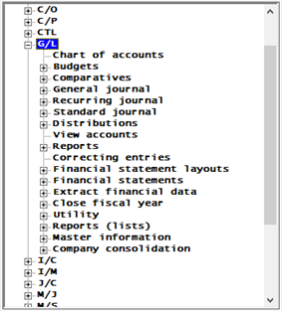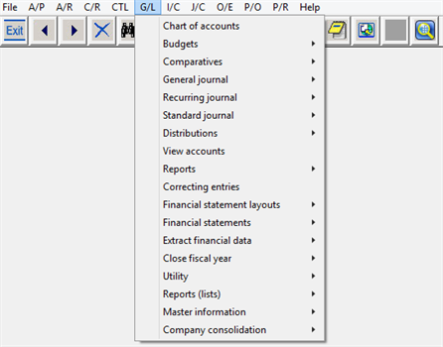
This contains the following topics:
This documentation provides the information you need to know on the Passport Business Solutions General Ledger.
The next chapter is a guide to daily operations. It explains how you use General Ledger to perform various daily, weekly, and periodic tasks.
After the guide, the next few chapters give instructions on entering basic information to set up your module according to your needs and to prepare you for daily operation.
Next are chapters which you will use most frequently. They describe how to use General Ledger on a daily basis.
The last few chapters describe selections which are used periodically, including such selections as compressing cleared entries.
Additional information such as; defining multiple companies, passwords, advanced features, and data recovery utilities, can be obtained from the PBS Administration documentation.
Each chapter of this documentation provides instructions on how to use a particular selection of your software.
The instructions include examples. In fact, you can go through the documentation and enter the examples shown in each chapter. This will demonstrate the capabilities of your new software. Each chapter has sample printouts of the information entered during the examples for you to compare.
If you enter the examples, you will want to initialize the file / table before you begin entering your actual business information. When you initialize data, you mean to clear out all information that you have entered for that file / table. The initialization procedure is explained in the PBS Administration documentation chapter called Initializing Data. After initialization, you would restart with this chapter and enter your actual business information. Only PBS Administrative users have access to this document.
Help refers to descriptions of functions which appear on the screen by pressing a designated key. The Help text gives you a quick reference to the highlights of functions while you are running the application.
Graphical Mode
In this mode help is accessed via the <Ctrl+F1> keys. The link may be to the chapter, a section of a chapter or a field. From there you may access the entire chapter. At the top and bottom of the chapter there is a link to "Open topic with navigation". From there you may access the documentation for the entire application (module).
Character Mode
Help is accessed via the <F8> key.
You can press the <F8> key at any time from any field. Pressing <F8> once will retrieve either a data lookup window or on-line Help about a task or selection you are currently using. If a data lookup window displays but you want Help, press <F8> a second time.
Look-ups refer to a list of available entries for a particular field. Many fields allow you to press a designated key <F8> to show all available data on file. For instance, when entering an invoice you may press this key at the Account number field to bring up a list of all G/L accounts on file. Selecting an entry from this list is often easier and faster than remembering the account number or stepping through all possible entries until the right one is reached.
The calendar lookup provides a point and click window for finding and entering date fields.
In Graphical mode the calendar lookup is available via the <F4> key. In Character mode access the date lookup via the <F7> key.
To start your Passport Business Solutions software, select one of the following options. If you are unsure how to proceed, please contact your supplier.
For Windows
Start- > Programs -> Passport Business Solutions -> PBS
For Linux
Ensure you are logged in as a user authorized to use Passport software. Refer to the PBS Administration documentation for more information.
Type the following:
cd /usr/pbs
or replace “/usr/pbs” with the name of your Passport top-level directory.
Then type the following:
pbs
If you have set up your software to process information for more than one company (see Define Multiple Companies in the PBS Administration documentation, you will be prompted to enter the Company no.
You are prompted to enter your User ID initials.
You will be prompted to enter your password. A user may reset his or her password during log in to PBS.
For security, the characters you type will not display on the screen. To setup passwords, see PBS Users chapter in the PBS Administration documentation.
Then when the master menu appears, select the module you wish to use from the master menu.
A menu is a list of things from which something can be selected.
Selecting an item from a menu on a computer is the way you tell your computer what you want to do.
The Windows and Thin client versions of Passport Business Solutions can have three different menu types. They are: Tree-view, Windows and Menu-bar.
The SCO Open Server and Linux versions only use the Menu-bar.
The following screen is a Tree-view menu display:

The “+” corresponds to expandable menu sections. You can open a tree view menu two ways:
| • | One click from the mouse will open the menu selection for the application or the sub-menu of a particular menu entry. |
| • | Select the right arrow key to expand the menu or sub-menu. |
Clicking on the “-” or selecting the left arrow key closes the menu item.
Viewing application menus will cause a vertical slider bar to display: and sometimes depending on size and proportions of the screen and associate font, the slider bar as well. These sliders are mouse enabled.
In addition to the mouse-based menu operation, you can use the keyboard to navigate the tree-view menu. The home, end, page-up, page-down and arrow keys provide a quick and easy method of maneuvering around the menu. As stated earlier the left and right arrow keys open and close the menu.
To select the menu program use the Enter key or click on the menu line with the mouse.
The windows menu provides another option.

This menu type is accessed by the mouse or by the F10 key.
You may use the mouse to access any part of the G/L menu.
If you prefer to use the keyboard select the F10 key to access the menu. You may also select the 'g' key and it goes to the G/L menu. After the menu displays you may type the first letter of a displayed menu item. When you do the cursor goes to the menu selection. If more than one menu item starts with the same letter, pressing the letter again will position your cursor over the next menu item starting with that letter. Use the right arrow key or the enter key to access sub-menu selections. To close a sub-menu use the left arrow or the escape key. To select the function press the enter key.
The menu-bar type is the classic version of the menu that has been available since the 1980s. Many long time users of RealWorld and Passport were trained on this menu type and prefer it. For people using Passport for the first time, this menu has an "old" non-graphical look and feel that could confuse new users.
To navigate horizontally between individual modules use your keyboard’s left and right arrow keys. Up to ten modules and your Passport Business Solutions System Manager may be displayed on the menu bar. If you are using more than ten modules, a More function is added to the menu bar. To access your additional modules, highlight More and press your <Enter> key.
To navigate vertically within a module you have two choices. You may use the up and down arrow keys on your keyboard or you may type the first letter of a displayed menu item. If more than one menu item starts with the same letter, pressing the letter again will position your cursor over the next menu item starting with that letter. To select one of the functions shown above, use the arrow keys, or press the first letter of the function name, and then press <Enter>.
To exit a module, press <Esc> twice from the main menu. To exit a sub menu, press <Esc> to return to a main menu.
To exit in Windows you can also click on the Exit button twice from the main or sub menu.
It is recommended that you exit PBS whenever there are long periods of time you are not entering or processing data. Always exit PBS at the end of the day.
Never turn off your computer with PBS open. Exit PBS first.